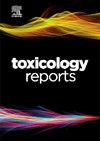全面评估人类健康风险的方法,整合自来水的物理化学质量属性和重金属含量
Q1 Environmental Science
引用次数: 0
摘要
重金属污染是影响自来水水源安全的一个严重问题。因此,本研究评估了埃塞俄比亚贡达尔市自来水中有毒金属含量的理化质量指标、致癌和非致癌健康危害。结果表明,除溶解氧、盐度和亚硝酸盐外,其余质量指标均低于允许质量标准。铁(Fe)的平均浓度、铜(铜)、铅(Pb)、铬(Cr)和镉(Cd) 范围从0.003 mg / L - 5 mg / L, 0.475 mg / L 0.752 mg / L, 0.14 mg / L 0.703 mg / L, 0.261 2.182 mg / L mg / L和0.035 4.286 mg / L mg / L,分别。金属在不同地区的平均水平降低的顺序:基于“增大化现实”技术的祝辞 AZ1 祝辞 PS1 祝辞 AZ3 祝辞 PS2 祝辞 先生在 PS3 祝辞 梅毒性心脏病祝辞 AZ2 祝辞 CL。除Cu外,Fe、Pb、Cr、Cd均超过WHO/FAO规定的安全限值。主成分分析和聚类分析表明,人为活动是重金属的主要来源。采用慢性每日摄入量(CDI)、目标危害商(THQ)、危害指数(HI)和增量终生癌症风险评估(ILCR)评价人体健康风险。除AZ1、PS3和AR中的Pb外,所分析的成人金属的摄入和皮肤途径的THQ值均在安全范围内(THQ <1)。但HI值的分布格局为PS1 >; PS2 > AZ3 > MR > PS3 > AR > AZ2 > AZ1 > SHD >; CL。除CL中的HI值外,其余均大于1 (HI > 1),表明这些地区的自来水可能存在非致癌性健康风险。致癌性健康风险分析表明,重金属终生致癌风险(摄入途径和皮肤接触途径)符合自来水可接受范围(10-6 - 10-4)。这一发现为制定旨在提高所研究地区水质标准的精确行动计划提供了宝贵的投入。本文章由计算机程序翻译,如有差异,请以英文原文为准。
Holistic approach to assess human health risks, integrating physicochemical quality attributes and heavy metal levels in tap water
Heavy metal contamination is a serious concern affecting the safety of tap water sources. Hence, this study evaluated physicochemical quality indices, carcinogenic and non-carcinogenic health hazard derived from the level of toxic metals in tap water in Gondar city, Ethiopia. The results revealed that except dissolved oxygen, salinity and nitrite, all quality attributes were below the allowable quality standards. The average concentrations for iron (Fe), copper (Cu), lead (Pb), chromium (Cr) and cadmium (Cd) were ranged from 0.003 mg/L to 5 mg/L, 0.475 mg/L to 0.752 mg/L, 0.14 mg/L to 0.703 mg/L, 0.261 mg/L to 2.182 mg/L, and 0.035 mg/L to 4.286 mg/L, respectively. The mean levels of metals in different areas decreased in the order: AR > AZ1 > PS1 > AZ3 > PS2 > MR > PS3 > SHD > AZ2 > CL. Except for Cu, the concentration of Fe, Pb, Cr, and Cd exceeded the safe limits described by WHO/FAO. According to principal component analysis and cluster analysis, anthropogenic activities were found to be the major source of metals. Chronic daily intake (CDI), target hazard quotient (THQ), hazard index (HI), and incremental lifetime cancer risk assessment (ILCR) were employed to evaluate human health risks. Except for Pb in AZ1, PS3, and AR, the values of THQ for both ingestion and dermal pathways from the analysed metals for adults were within the safety limits (THQ 1). However, the distribution pattern of HI values were presented in the decreasing order: PS1 > PS2 > AZ3 > MR > PS3 > AR > AZ2 > AZ1 > SHD > CL. Except, the HI values in CL, all values were greater than one (HI > 1), indicating that tap water in these areas may pose non-carcinogenic health risk. The analysis of carcinogenic health risks indicated that the lifetime cancer risk (ingestion and dermal exposure pathways) of heavy metals were in accordance with the acceptable range for tap water (10–6 – 10–4). This finding provides valuable input for the development of precise action plans aimed at elevating water quality standards in the studied areas.
求助全文
通过发布文献求助,成功后即可免费获取论文全文。
去求助
来源期刊

Toxicology Reports
Environmental Science-Health, Toxicology and Mutagenesis
CiteScore
7.60
自引率
0.00%
发文量
228
审稿时长
11 weeks
 求助内容:
求助内容: 应助结果提醒方式:
应助结果提醒方式:


